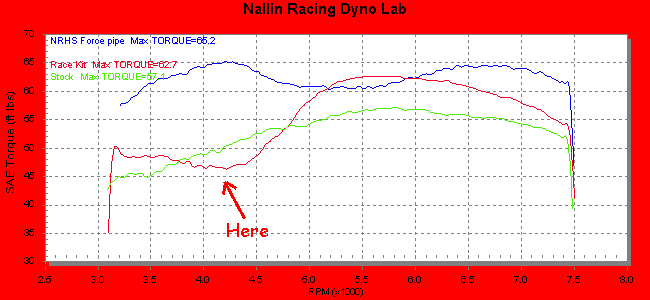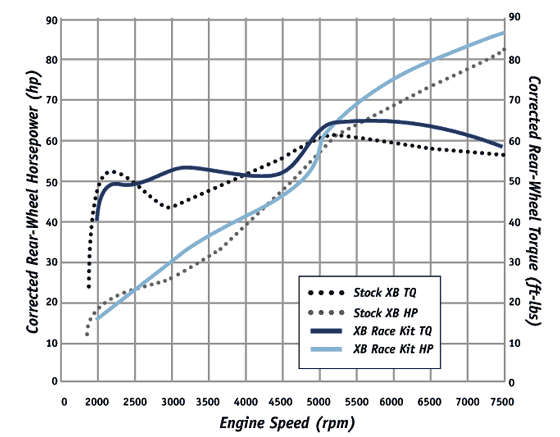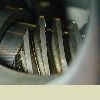| Author | Message | ||
Glitch |
Aaron said this about the XB9 exhaust. What I'm wondering is the header the restricting factor? I've got the Buell Race Kit, and was wondering if headers would help things, or is the muffler restricting the flow. I guess what I'm asking is, is it possible to come up with a header that will mate with the Buell Race Can and improve performance. | ||
Mikej |
Define where you want the power, or how you want the power profiled and available, then tune the exhaust towards those goals. Sometimes a restriction properly placed will improve desired performance. Define your desired end result, work backwards adjusting obstacles along the way to get there. Some experts say the pipe is the problem, some say it isn't, I say it all depends upon the rest of the equation as to how much of a limiter the muffler is. With the S1 bike pic posted on another page, the two exhaust pipes will behave differently due to the bends in the front pipe. As such each pipe should have been tuned to length individually. Define your goals, work from there. There is no one single best answer, at best there are several good viable answers to each question because power delivery is so fluid and interactive with current conditions. | ||
Glitch |
I'd like to get the dip out of the torque curve.  | ||
Mikej |
That looks like something isn't set up right if you have the factory full race kit installed. I'll defer to some of the TPS module experts here. | ||
Glitch |
Maybe you're right. Here's the one from Buell. I've always heard factory's dynos are optimistic is why I used Aaron's. Either way I'd like to take the dip out, and thought that maybe the header was one way to go, as I don't want to get rid of the muffler I have now.  | ||
Aaron |
No, that's pretty typical of the XB race kit's torque curve. It ain't the same as the tuber race kit at all. It's got a massive reversion going on there. Bends are in the noise (hah! I kill me!) compared to length, diameter, and step location. | ||
Aaron |
Those two charts look basically the same to me. The factory's chart goes a little lower in rpm but the shape of the torque curves is the same as the chart I did. | ||
Glitch |
So lengthening the pipe would make the peak go in which direction? Or would making the curves more gentle do it? I wish I had a welder and a box of curves! Oh, and a dyno, and a shop, and every tool I ever needed.... Or better yet...if I only had a brain... | ||
Aaron |
The primary effect is wave travel. Envision a rock being tossed into a calm pond. The pressure waves travel outward, then reflect off the edge of the pond and come back. The smaller the pond, the sooner they make it back. Same thing happens in an exhaust system. Pressure waves, both positive and negative, are travelling up and down the pipe. The idea is to get a negative pressure wave to hit the chamber during overlap (i.e. when both valves are open). Overlap happens as the piston is travelling through TDC, finishing it's exhaust stroke and beginning it's intake stroke. A negative wave arriving right then will pull on the intake and gets the next fuel charge moving before the piston even starts pulling on it, significantly increasing cylinder fill and cylinder fill is what you're looking at when you look at a torque curve. As such, generally speaking the more overlap in the cams, the more influence the exhaust system has on the powerband. Anyhoo, the problem is that the motor is operating over a wide range of speeds, but the waves travel at a pretty constant speed. So if you've got the pipe sized such that a negative wave arrives at say 5500rpm, at 4200rpm that wave isn't timed right anymore. Or worse, you could have a positive wave arriving at 4200rpm, which just kills cylinder fill (any resemblance between that example and the race kit's torque curve is intentional). Getting a broader powerband, which is what you're asking for, is typically accomplished by diffusing the wave, such that you make it broader. Now it arrives at the chamber over a wider range of rpm. This will show up as a broad, parabolic torque curve. The stock system in the Nallin Racing dyno sheet above is a reasonably well diffused wave. The problem is that diffusing a wave also weakens it. You can make more power by concentrating the wave over a narrower & higher rpm range, which is pretty much what they're doing with the race kit it appears to me. You can see what a cool thing that valve in the XB12's muffler is when you understand all this. The damn pipe can basically change it's length (and therefore it's wave timing) on the fly. I believe the bigger question you're asking, though, is how does the length and diameter of the header and muffler play into the shape and timing of the waves. And that's a whole lot more complex question, particularly with a 2 into 1 on a motor that fires at uneven intervals. To answer it, you have to identify the events that generate waves, as well as characterize the speed of the exhaust and the speed of the waves, and come up with a prediction of how it's going to behave. Just to make it a little more complex, the speed of the waves varies tremendously with temperature, as does the density and therefore the velocity of the exhaust, and the exhaust is cooling as it goes down the pipe. Accurately characterizing what's happening in an exhaust system is not trivial. I'm certainly not all the way there, but I have created a spreadsheet that helps me design 2 into 2 systems, and I've tweaked on it here and there as my understanding has grown and it seems to be working, i.e. the dyno results are matching my intentions. Basically you can punch in bore, stroke, exhaust open point, and target torque peak rpm (75-90% of the power peak rpm depending on the application), pipe sections diameters and lengths, and it'll show you exhaust velocities and wave timing. It's then an iterative process to come up with pipe dimensions that generate velocities and timing that makes sense. I haven't really worked on 2 into 1 systems yet, although I *think* I understand the mechanisms involved. I can tell you that the exhaust velocity comes out basically correct with 1-5/8 head pipes on an XB9. But I haven't studied the lengths they're using and tried to figure out how their design works. Someday when I get time. | ||
Glitch |
Aaron: You are a multi-talented man. The way you explained this was excellent! I understand what you are saying. I know how the valve works in the XB12, and can't understand the rush to disable it (unless of course they just got to have more sound). The timing you mentioned at 4200 rpm, would that have anything to do with the timing change in the Race ECM? Would going to the stock ECM help? Or, is this a whole different animal all together (although it all seems to be tied together to me)? Thank you for your time. I really do appreciate it. | ||
Aaron |
No, the 4200rpm hole in the torque curve is because the exhaust is timing a positive pressure wave to arrive at the chamber during overlap at that rpm, it really has nothing to do with the ECM. It's pushing back when it ought to be pulling. I can't see fixing it with the ECM. On carb'ed bikes, a reversion like that causes the motor to go rich, and you can add a carb circuit (Thunderjet from Zipper's) that lets you lean it in that area without leaning it on top, and you can smooth it out a bit, but that shouldn't be much of an issue with injection. | ||
Reepicheep |
My question is what would be involved in retrofitting the 12 exhaust on a 9... and if it would be effective. | ||
Aaron |
They went back to 1-3/4 primary tubes for the 12's, right? So velocity will go down. Velocity is: (piston speed in fps) * (bore^2 / diameter^2) Say at 6000 rpm ... the 9's piston speed is 3125fpm which is 52fps. With the stock 1-5/8 primary tubes (1-1/2 i.d. roughly), you get: 52 * (3.5^2 / 1.5^2) = 283fps 280 to 300 is considered the ideal range, below that loses inertia scavenging and above that causes pumping losses from the friction. Now, with a 1-3/4" head pipe (1-5/8 i.d.) ... 52 * (3.5^2 / 1.625^2) = 241fps So it's a little low. To get back to 280fps you'd need to get the piston speed up to 60fps, which is 3600fpm, which is 6900rpm. This difference in exhaust velocity is going to affect the wave timing, because waves are generated whenever the exhaust is allowed to expand (i.e. steps, collector, muffler, outlet). So if it's going a different speed, waves are generated at different times. And therefore lengths have to be different to get the waves timed to arrive at the chamber correctly. Now, in terms of the muffler, the main thing is you've got nothing to control the valve with, right? That's done with the 12's ECM I suspect. And if you put the 12's ECM onto the 9, you'd lose the 7500rpm rev limit. Not that you or I couldn't whip up a simple control that moved the valve at user selectable rpm points  ">"> If it was a big enough market, I'd mess with it. Embedded systems and firmware for same is my "real" job. ">"> If it was a big enough market, I'd mess with it. Embedded systems and firmware for same is my "real" job. If I ever get around to making an EPA illegal muffler with a valve in it I'll do the control. edited by Aaron on September 12, 2003 | ||
Reepicheep |
Heck, forget setting it by RPM, make it closed loop based on acoustic signatures. Instead of a valve, make it a linear actuator for an adjustable chamber length. It could be a completely bolt on part (well, bolts and two wires). edited by reepicheep on September 12, 2003 | ||
Glitch |
Thanks Aaron! | ||
Reepicheep  |
Aaron... what kind of range of motion would be required to cover the whole RPM range on an XB9? This is likely a moronically stupid question, but why would not a sort of passive system work? I am picturing a perforated tube, with a loose piston in it, that is spring loaded. The higher the RPM, the more exhaust pressure is generated, and the more the piston moves (making the exhaust pipe either longer or shorter as necessary). This is obvious enough that I am sure it has been tried. Why didn't it work? An electrical control would be pretty simple as well, and likely more reliable. It would not even need to connect to the ECM, a piezeoelectric sensor could easily "listen" to RPM and be plenty reliable (AFAIK). (Message edited by reepicheep on November 29, 2004) | ||
Nextcorner |
I'm saving up for D&D Exhaust with ECM. Are there any temporary solutions for making XB9R Stock Exhaust LOUDER?? |